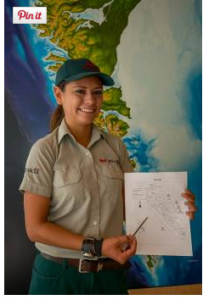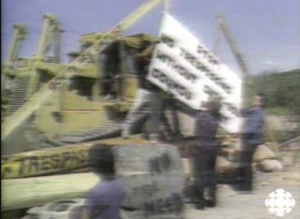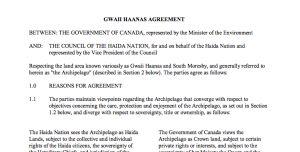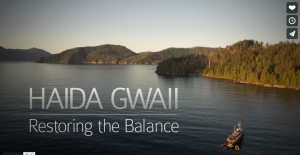Despite the belief of many people that the Lyell Island blockade would hurt the local economy by ending logging, twenty five years later we have a different picture. This is a tourism website created by Destination BC, a crown corporation dedicated to promoting British Columbia tourism. I can personally attest that Haida Gawii and Gwaii Haanas park are wonderful places to visit where many Haida work in the tourist industry.
Author Archives: slerch
19 Four Years After the Lyell Island Blockade
A CBC clip four years after the Lyell Island blockade describing the use of blockades by Canadian First Nations and how those blockades led to treaty recognitions. This is another example of how Canadian First Nations started to realize the potential of media coverage and the advantages of utilizing technology to their benefit. Also, look at the links at the bottom of this page and you will find many digitally archived videos of Canadian First Nations and their battles for treaty rights.
18 The agreement that created Gwaii Hannas Park
This is the actual Gawii Haanas agreement between the government of Canada and the Haida Nation that lead to the formation of the park. This agreement paved the way for many others after it.
17 The Blockade at Lyell Island
This is a CBC archives video of the blockade at Lyell Island. One of the main complaints of people opposing the blockade was that it would hurt logging; Haida worked in the logging industry, but many also relied on salmon fishing. The people who blockaded Lyell island believed that cutting the forests down would destroy the salmon spawning grounds and their fishing livelihood, something that is now substantiated by science. Today, Haida Gwaii and Gwaii Haanas park are a major tourist destination.
http://www.cbc.ca/archives/entry/loggers-confront-haida-blockade
16 Haida Gwaii, Restoring the Balance
This is a link to a video called Haida Gwaii, Restoring the Balance. It was produced in partnership with the Council of the Haida Nation, and discusses the environmental and land claim issues of the Haida people, including the historic blockade at Lyell Island, which eventually led to the creation of Gwaii Haanas park. This is an example of exceedingly well done social media marketing; I first came across this video through Facebook, which linked me to Vimeo. The cinematography is incredible using high definition video, flying drones, interviews and vintage footage from the CBC archives. This video could be used to show to students giving them the perspective of the Haida people and as a launching point for further investigation into First Nations issues.
15 A third point of view from Big Business
This is an article written in the Financial Post, about Petrona’s 1 billion offer to the Kw’alaams tribe. This is a Canadian business newspaper, which leans to the right, and their bias is evident when you read the article. They claim that the $36 billion project is a litmus test that could determine how other large companies invest in Canada. If the Kw’alaams tribe derails this deal, Canada will have trouble attracting capital. In the “Related Articles” section the first title is “Are investors getting ready to bet against Canada – Again?” This website demonstrates fear mongering and opposition to first Nations’ efforts to preserve their land.
14 The Oil Giant vs. BC First Nations
This is the website of the Malaysian oil company Petronas, which offered the Lax Kw’alaams tribe over a billion dollars to use their land, and were turned down. If you have ever been to Kuala Lumpur, then you have seen their huge twin towers that dominate the city. This website is very slick, offering wordy sections on how good this company is for the environment, communities etc. In their reports, they emphasize their willingness to work with the local First Nations tribes of BC which, as far as I can tell, they have been doing.
13 The Lax Kw’alaams Tribe
This is the website of the Lax Kw’alaams tribe near the mouth of the Skeena River. They currently oppose oil and gas development on their land because they believe that it will hurt the fish habitat and have turned down over a billion dollars from the Malaysian state-owned oil company Petronas. It is a basic website that describes their history, gives the latest news, but most importantly links to their study on the potential impact of oil and gas development in the area. Although they claim to have 200 000 fish samples, there are no data, methods or analysis that I can find in this study. I think if they had used a third, non-biased, party conduct this study, it would have held more weight and legitimacy (although it did get the oil company to make a large offer).
12 Turning down a billion dollars
This is an article from the New York Times describing how the Lax Kw’alaams Band in BC has turned down over a billion dollars from the Malaysian energy company Petronas because they believe that their fish habitats are more important. I found this media representation of the issue to be quite balanced, giving both sides of the story.
11 Indonesian Indigenous People
I learned about this website after attending the conference on indigenous peoples, forests and climate change on October 8th 2015 at UBC. The conference included indigenous people from all over the world talking about what they are doing in their countries to prevent deforestation and environmental harm. When I asked the representatives how they use the Internet and technology to further their cause, most of them had basic websites, with links to Facebook and Twitter. Some, such as the representatives from the Congo area, did not even have that, but collaborated with the press and used television. It seemed to me that Canadian First Nations are on the cutting edge of technology use. This website is an example of what the Indonesian indigenous people use. Compare it to my previous posts from Canadian First Nations websites in effectiveness of getting their message out, ease of use and relevance. You will have to use Google Translate.









